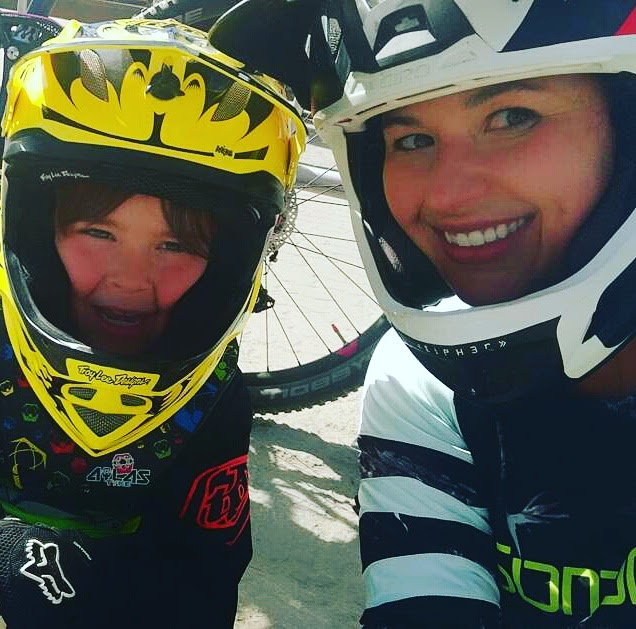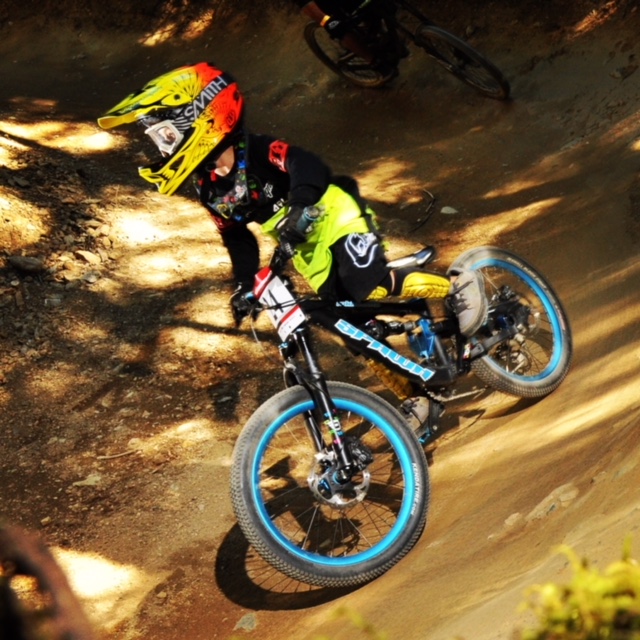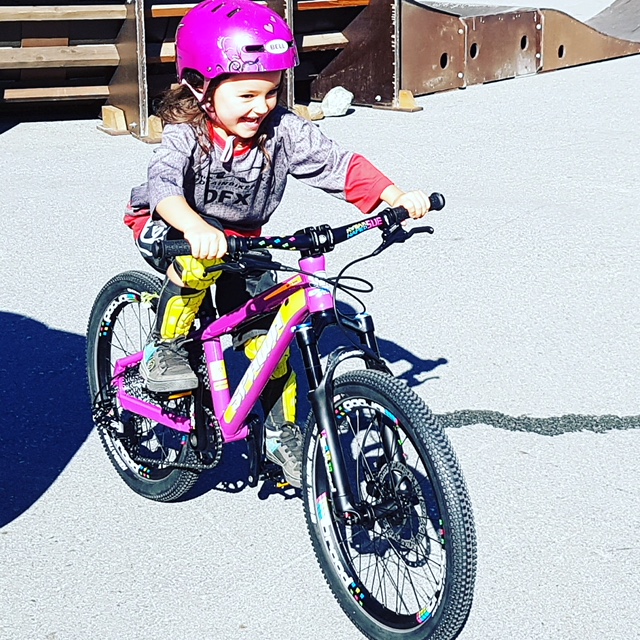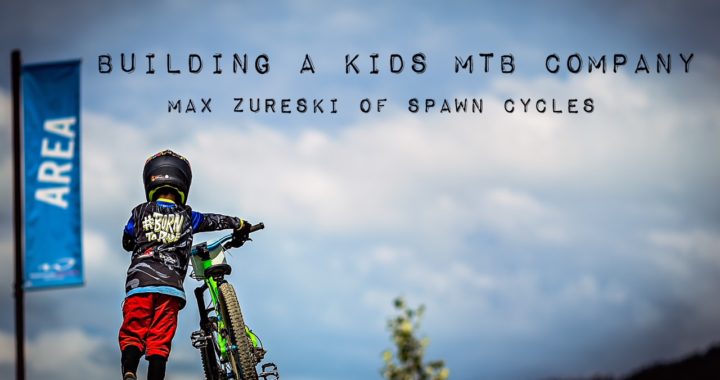Building a business takes passion, sacrifice and dedication. We talk to Max Zureski about his family journey building Spawn Cycles, a kids MTB brand and pushing kids bikes to the next level. His hard work is elevating kids mountain bikes to what we expect from adult bikes and allowing kids to do amazing things on two wheels. It's hard not to be envious of Max...living the life in Squamish BC, working on Bikes and building something to be proud of. Have some sympathy though, Max mashed his ankle in a bad way Dirt Jumping this winter (think pins and multiple casts). Heal up Max! We hope to see you on the trails soon.
What was the motivation to start Spawn Cycles?
We first introduced our son Danny to a balance bike when he was about a year and a half old. As many kids do, he progressed pretty quickly and was ready for his first pedal bike by the time he was 2.5 years old. When we looked around at a few local shops I was blown away that kids’ bikes really hadn’t gotten any better since I was a kid myself. After doing some research and spending a bunch of time in Taiwan, I basically just hammered out the designs for the first 14” and 16” models as well as a balance bike with a v-brake. We made the first bikes shortly after that. It seems like a pretty insane thing to do looking back at it now.
Has it been a family affair to get Spawn viable and thriving? Did Spawn start as a side hustle?
It’s completely a family affair and was a side hustle for a long time. The kids have always been involved as both the inspiration for what we make and as our little prototype testers. My wife, Elena, has been involved in pretty much everything since day 1 with the business and has been very supportive in what was a pretty risky venture. We got started in late 2011 and I just ditched my day job at the end of 2015. I think we’ve broken a lot of ground on designing and tooling components ourselves and that has taken a lot of money. As in, sell-our-house money. We definitely weren’t in a position to do this full-time until quite recently, given all the investment it has required to make stuff that really didn’t exist before.

It sometimes can seem like bike companies are bigger than they are…tell us about the people, scale and reach of Spawn. I imagine you are doing a lot with very little people.
We have people calling and emailing and asking to speak to our marketing manager or procurement specialists or whatever. We don’t have any of that. For the most part it’s my wife Elena and I. We have a few key people who help out as contractors in specific areas like social media and customer service as needed and some very dedicated vendors we work with in Taiwan that make everything possible. We distribute through Canada, the US, Australia, New Zealand and parts of Asia ourselves and have a small distributor in Europe who is direct to consumer. But no full time employees other than Elena and I.
We’re one of the larger and more well known brands that’s strictly doing kids’ bikes, but it’s a pretty small pond. To keep prices as reasonable as we can while putting out the best quality bikes means running the business as lean as possible.
What’s your opinion why the big brands have not adapted their kids’ designs over the years?
I guess there was no real reason to for a long time – balance bikes were really what has driven the change and the need for better kids’ bikes. The big brands have also worked exclusively through shops forever which means that they need to make bikes with mass appeal that hit a price point. You can’t physically make an inexpensive, light, and strong bike with unique features where a shop, a distributor, and a brand make enough margin to survive. I think that’s why all the kid-specific brands are relatively new and sell direct-to-consumer. It’s taken flattening the distribution structure, the development of e-commerce and probably the emergence of the gig economy where we can find people to do a few hours of coding or photoshop or whatever we need on demand. It’s really the only way to make bikes that have a niche market appeal and a lower profit margin work.

How has the demand for particular bikes changed over the last few years? Are parents asking for and willing to pay for premium spec’d bikes for particular niches (i.e. Suspension/disc brake MTB’s)?
I think parents are now more aware of the difference that quality bikes make in kids’ enjoyment of the sport and their ability to progress. Given the amount of time kids spend on a bike, it’s an amazing value compared to sports like hockey or skiing. When you take the high resale value of our bikes into account, I think it’s a no-brainer compared to a department store bike that a kid won’t ride and that you can’t resell. This awareness has allowed us to move upmarket and continue to innovate and improve.
We can invest in tooling for specific forgings or to make our own tires when there are enough parents who get it and are willing to buy these parts. People are a lot more likely now to understand the benefits of this or that feature or component instead of just saying “good enough”. In parents’ minds now, I think our bikes are getting compared on quality to adult bikes, not just on price to department store bikes. The parents buying Spawns aren’t riding department store bikes, so they generally get it.
Parents who ride are pretty likely to say on Instagram or on a internet forum that they’re totally going to buy some rad full suspension bike for their 3 year old to “shred the gnar” when they’re big enough, but not that many people are actually willing to get those bikes once these kids turn 6. As parents I think we all get a little dose of reality once the kids are in school and 10 different activities as to how much time they will have to ride certain types of terrain. Really solid XC/trail hardtails outsell full suspension bikes by a wide margin because that’s what most kids can use on a relatively consistent basis unless they live in an area with really crazy terrain or a park nearby.
What are some of the challenges designing and manufacturing kid’s bikes? How do you get guidance or develop the skill to design such amazing little machines?
It’s getting easier for us I think, but at the start, it was incredibly hard. Whether it was manufacturers in Taiwan or bike shops here, there were very few people at the start who got it. The industry help we had in the early years was really just from the people who had kids around the same ages as ours - they absolutely understood why we were doing this and many were willing to help out by providing their experience or contacts. Without those people, some of whom are pretty well known in the industry, we never would have gotten to where we are now. Everyone else at the time had a picture of a heavy, mild steel bike with a basket and coaster brake when you said “kid’s bike”. We were basically taking components designed for adults and finding ways to rework or remachine them. It was really challenging.
As things have progressed, we’re now taken somewhat more seriously in the industry; the bigger component manufacturers are more likely to talk to us and help out and we can do custom projects and tool up for what we think kids actually need. You couldn’t imagine how hard it was to make our first tires as an example – no one wanted to do it. It was almost 2 years of banging my head against a wall.
People still look at me sideways sometimes when I have an idea, but there’s less laughter now. We’re finally at the point where people within the industry know we exist and it’s really helped us get the product to where we want it. That said, I still make sure I have videos of what some of the team kids are doing before I go into any meeting to make sure that the component manufacturers understand what we need.

The Furi 14 and Banshee 16 were such revolutionary kids bikes. How did you improve on such bikes with the Yoji 14 and 16?
We had so much trouble at the start, but these days it is way better and we can make what we really want to. We chipped away at the Banshee over the years with frame improvements, drivetrain improvements, the Loam Star tires, but I had a list for the last few years that I just added to every time I saw something I wanted to tweak like a semi-integrated headset, or a Pivotal seat to get the seat height down without shrinking the seat tube, or really nice grips or moving to a rear hub with a real freehub and a hollow axle. When the list got substantive enough and we had the chance to tool up all the new stuff we wanted to do, I felt like it was time to just release new models. We’ve basically done the same with the Yama Jamas replacing the Savage 2.0 and the Shojo. It’s kind of gratifying that some other companies are making basically what we made 5 years ago and those bikes are being well received. I think we’ve always been on the right path to make what we want to make, but I think we’ve upped our game with the new models. Not everyone will need this stuff or appreciate what went into the changes, and some people will disagree with what we prioritize, but I’m very, very comfortable that we’re making what we’re supposed to make.
You were one of the first to develop a specific 20 inch fork that works for light weight riders. I imagine that was a crazy project. How low can we go? Is a 16 inch fork in the future for 4-6 year old trail slayers?
The Brood fork was actually one of the less challenging projects in the last few years. The manufacturer we found had something very good we could start with and we’ve just made incremental changes to improve what we could on them. I honestly don’t see a whole bunch more happening on that front. If you look at the longer travel version of the Brood fork or other 20” forks with longer travel, you’re getting longer lowers and higher arches as you go past about 80mm of travel. If you made an 80mm 16” fork, it would honestly just be the same fork as the 80mm 20”. To have Xmm of travel and fit in all the stuff you need, the lowers need to be a certain length. You also get to a point where the kids don’t have enough weight to make suspension workable, let alone necessary. I think forks have probably went as far as they will for a little while.
A rising tide raises all ships…What’s your thoughts on the explosion of direct to consumer quality bike companies? Is going to the bike shop to purchase your child’s bike a dying experience or is there room for both channels?
After seven years in the business, this is the toughest question we get asked and it is getting harder and harder as there are some pretty strong feelings on the subject. The honest answer is that we’ve spent a ton of time thinking about this, talking to people about it and considering how it affects where we fit into the world. This comes up literally every day for us.
I think the good shops out there are incredibly important for communities and advocacy, supporting events, trail building, and making the sport accessible to new riders. We’ve got a few amazing shops we work with that do a ton for the sport and have really incredible mechanics. That said, at least for me, buying a quality kid’s bike from a bike shop isn’t dying, because generally it was never really a thing. Before companies like ourselves, Islabikes, Lil Shredder, Woom, Commencal or whoever, the really high quality, well thought out kids’ bikes were pretty much all higher end BMX bikes. There have been a couple exceptions, but not many. And, at least where I grew up, you couldn’t get the good stuff at a local shop because none of them carried it - the local market for those products was just too small. My friends and I used mail order from ads we saw in BMX Plus or Freestylin’ magazines. That’s basically just a super slow version of direct to consumer e-commerce. And in my childhood, that’s how people got the best kids’ bikes. It’s easier and faster now for customers, but the concept is pretty much the same.
I’ve talked to a lot of industry people about this over the years and my general feel is that it’s always been really tough for a shop to justify using a floor spot on a $300 BMX bike or kids’ bike when they can use it for a $10,000 carbon road bike. And it’s gotten worse as property values and rents have increased. As a shop owner in most communities I would think that’s really tough to do and still make a living. The decline in that part of the market, which was all about getting kids excited about biking instead of focusing on 40 year old dentists, has probably played a big part in the drop in ridership among young people. And that is hurting the broader industry now. Over the last couple decades, there just hasn’t been as much cultivation for the future of the sport as is necessary.
Some shops hate us and other direct to consumer brands because they think we’re taking business from them or ruining the sport, but I think it’s absolutely the opposite. If smartphones are more accessible and more fun than bikes are for kids, the sport will die a slow death over the next 20 or 30 years so kids’ bikes needed to get better and the experience needs to be more exciting. If good kids’ bikes can’t thrive in most shops, they just need to thrive somewhere else. I really think that we’re helping as much as we can to get kids stoked to ride and getting parents stoked to ride with their kids. As a dad, that is literally all I cared about when we started Spawn. Along with the companies I mentioned before and some others, I think we’re all just collectively filling a hole that has existed for a long time. And some of the kids that ride for our team or ride our bikes will be pros someday inspiring the next generation of kids - we’re already seeing this with some of the older kids that are Spawn alumni. In the end, I really believe that what we’re doing, no matter how small we are, plays a part in bettering things and helps in some part to grow the pie for the future of biking as a whole.

(Photo by clint trahan/clinttrahan.com)


